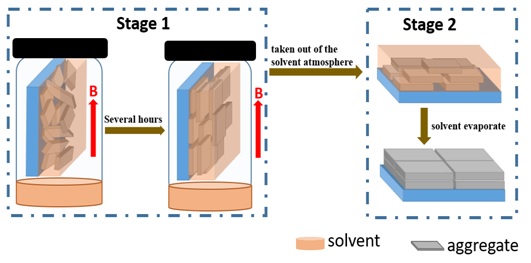Recently, with the assistance of high magnetic field (HMF), a research team proposed a new strategy for the organic semiconductor (OSC) film growth, which enabled successful structural control and significant improvement of charge transport properties for the high-performance semiconductor polymers.
The research team, which was led by Prof. ZHANG Fapei at the High Magnetic Field Laboratory (HMFL), demonstrated the highly oriented and ordered films of the semiconducting polymers achieved by solution-cast in HMF before. However, the prepared films often suffered from poor uniformity on morphology and thickness, which led to poor reproducibility of device performance of the organic films.
In order to solve such problem, the group developed a novel magnetic approach-solvent vapor annealing in HMF (referred as SVA-HMF).
The homogeneous "wet film", pre-deposited via spin casting, was placed in the atmosphere of saturated solvent vapor under HMF for "annealing" treatment. Large area (centimeter scale) film texture was achieved for a donor-acceptor (D-A) copolymer P(NDI2OD-T2). As revealed by the microstructural studies, the SVA-HMF films exhibited a remarkably higher degree of chain alignment and crystallinity compared to the HMF-guided drop-cast films, in addition to high morphological uniformity.
Basing on structural evolution of the films with the annealing time, a mechanism was proposed to elucidate the alignment process which emphasized that the chain aggregates re-formed in the swollen films trigger magnetic alignment. Field-effect transistors (FETs) of the aligned P(NDI2OD-T2) films exhibited an extraordinarily large mobility anisotropy of 102, as well as a 19-fold enhancement of electron mobility compared to the unaligned films.
In addition, large-area highly oriented films were prepared via SVA-HMF for another D-A copolymer PDPP2TBT, verifying universality of this approach on film structural control. The magnetically oriented PDPP2TBT films exhibited high hole mobility of 1.56 cm2/Vs. Temperature dependence of mobility revealed fast intra-chain conduction along the chain alignment with a promoted delocalization for carrier hopping via chain alignment.
Furthermore, the researchers found that the corporation of a small amount of graphene nanosheets to the polymer matrix further improved the degree of chain orientation of the semiconducting polymer films via SVA-HMF, and significantly enhanced mobility anisotropy of the OFET devices.
The work gave deeper insight into the mechanism about the magnetic field/molecules interaction as well as the film structure-performance relationship of OSCs. And the SVA-HMF strategy provided a simple and important route in materials discovery and performance optimization of organic electronic devices.
Schematic illustration of the SVA-HMF process for the alignment of an as-cast polymer film
